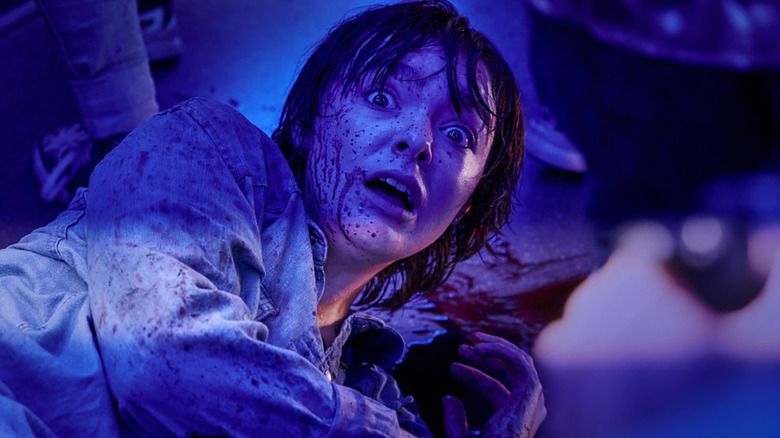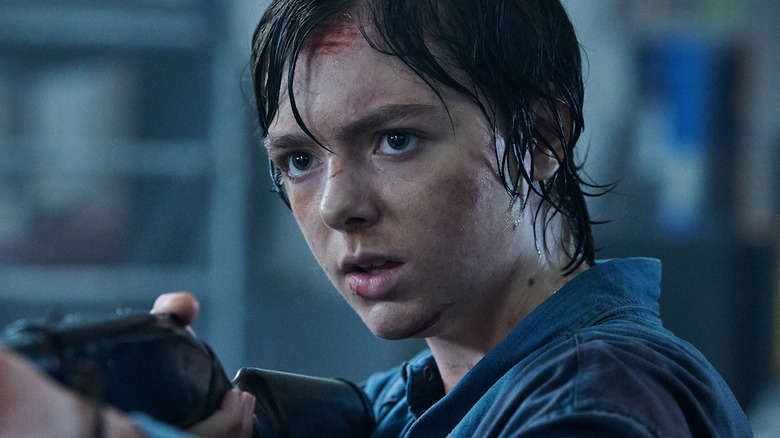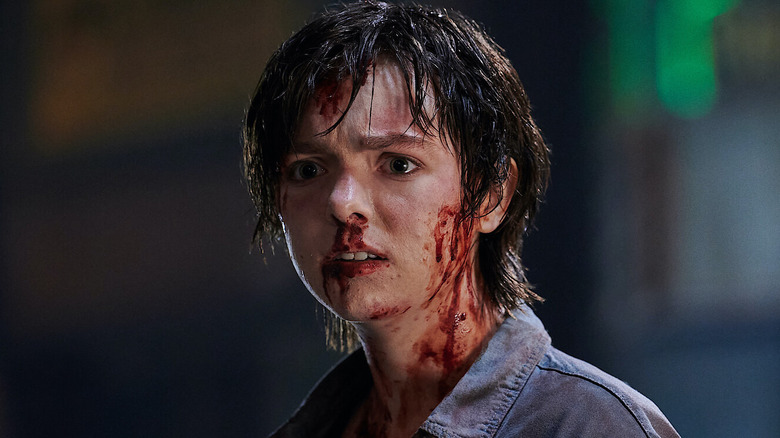Why The New Texas Chainsaw Massacre Might Feel Too Real
As a genre, horror films have always been about exploring the cultural anxieties of society. The things that we fear are largely determined by our lived experiences, and horror validates and reflects those feelings by putting them on screen. Using horror as a vehicle for social commentary is a wise decision, and allows audiences to think about their own relationship with the horrors of "real life," from the safety of a fictional story. Tobe Hooper's 1974 masterpiece "The Texas Chain Saw Massacre" was a perfect allegory for "Nixon-era mayhem," and the juxtaposition between the hippie movement against the fallout in rural communities from the oil crisis and economic recession. Now, just shy of a half-century later, Netflix brought us back to Harlow, Texas and gave the flesh-mask wearing Leatherface a bit of a facelift with 2022's "Texas Chainsaw Massacre."
Directed by David Blue Garcia from Chris Thomas Devlin's screenplay inspired by a story from Fede Álvarez and Rodo Sayagues, "Texas Chainsaw Massacre" is a direct sequel to Hooper's original film, disregarding the seven sequels, prequels, and remakes that came before it. It's the first film to feature an actual chainsaw massacre, and while Hooper's original chose for the film's social commentary to exist in the allegorical subtext, Garcia's "Chainsaw" proudly wears its messaging on its sleeve. Elsie Fisher stars in "Texas Chainsaw Massacre" as Lila, an amateur photographer who survived a school shooting, but is still rightfully traumatized from the experience. Garcia wanted to honor Hooper's original intent by making "a contemporary story to its time," which included the bleak reality that there's a high probability that a twentysomething character in 2022 has come face-to-face with the unfortunate epidemic of school shootings.
A new horror for real life
While the tragedy at Columbine High School in 1999 was not the first ever school shooting, it was the moment that sparked actual change in the way American schools and law-enforcement agencies prepare for deadly incidents. In the 23 years since, over 292,000 American students have experienced gun violence at their schools — that's the equivalent of the entire population of Orlando, Florida and double the population of Waco, Texas. The inclusion of Lila's character as a survivor of a school-shooting is unfortunately a needed normalization as horror moves forward, considering how disturbingly common the experience has become. Where the final girls of yesteryear were left to their own devices to figure out how to survive masked slashers, the modern final girl grew up with active shooter drills as essential to class curriculum as learning how to write the alphabet.
"I think her story is interesting because, as a survivor of trauma, to put her into a horror world, it's very interesting to tackle," Elsie Fisher said of the character. "But I don't want to let her be defined by the bad things that have already happened to her." Fisher, the brilliant star of Bo Burnham's "Eighth Grade," was put in an impossibly difficult role as Lila, a character who by merely existing was going to be politicized immediately as a school shooting survivor. The decision to make Lila a survivor was provocative, and would have likely been better received had "Texas Chainsaw Massacre" taken a stronger stance on what we're supposed to take away from the school-shooting angle.
Adults just don't understand
Producer Fede Alvarez was interviewed about the mixed messaging of "Texas Chainsaw Massacre," and unfortunately, his answers don't provide much insight as to what we were supposed to take away from the film as audience members:
The world is a f****** mess and [there's] shades of gray and there can be all sorts of characters in both sides of the story, so that's the way we approached it. We wanted you to walk out of it and go, 'Wait, but I still don't have an answer! Who was right and wrong?' Because that is the way that life works.
It's clear that the film's intentions were not to perpetuate dangerous talking points, but trying to play both sides of the debate surrounding gun control lumped the film into disappointingly messy territory. Lila sports a bullet wound on her chest, but is simultaneously captivated by the semi-automatic gun strapped to the hip of a local man named Richter (Moe Dunford). During the film's gory climax, Lila takes up arms and uses a shotgun to defend herself against Leatherface.
It genuinely feels like the movie is trying show that Lila has "overcome" her school-shooting trauma by becoming a shooter herself, which is a grossly irresponsible approach to the very-real trauma that students in a post-Columbine, post-Virginia Tech, post-Sandy Hook, post-Parkland, post-any number of school shooting tragedies face every day. There's absolutely power in reclaiming what has harmed us in the past, but as some of the oldest survivors of school shootings will tell you, their relationship with guns is complicated ... perhaps a little too complicated for a film like "Texas Chainsaw Massacre" to dare to tackle.


